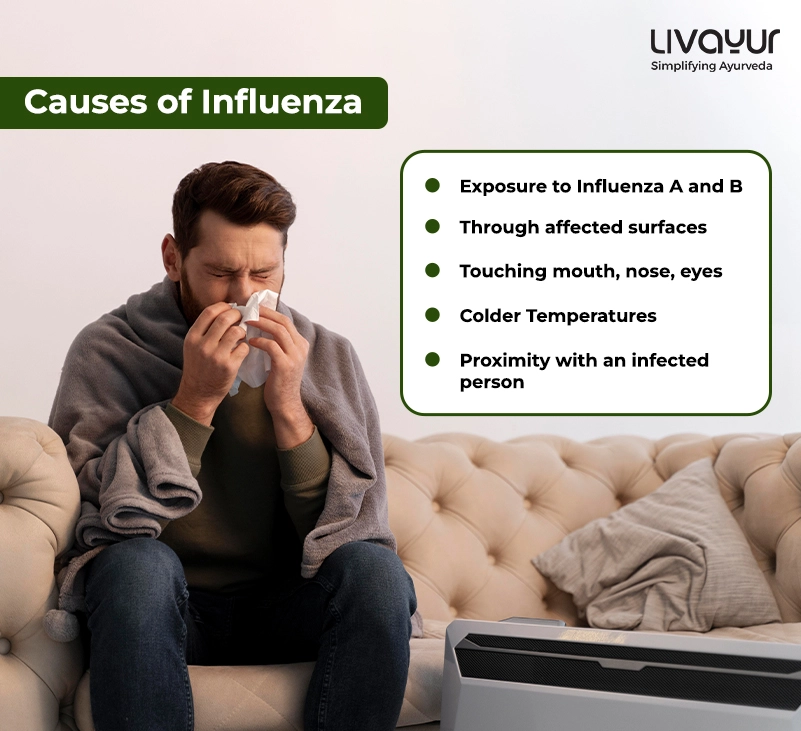This article is reviewed by an expert

Influenza, commonly known as flu, is a highly contagious viral infection that affects the respiratory system. It can cause mild to severe illness and in severe cases, can lead to hospitalization or even death. [1] This article will answer the question ‘what is influenza’ and will also inform you about influenza causes, symptoms, treatment and prevention. Read on:
What is influenza?
Influenza is a viral infection caused by the influenza virus. It spreads from person to person through the air when an infected person talks, coughs, or sneezes. The virus can also spread by touching a surface contaminated with the virus and then touching your nose, mouth, or eyes. [1]
Ayurvedic perspective on influenza symptoms [2]
According to Ayurveda, the symptoms of influenza include aggravation of the three Doshas – Vata, Pitta, and Kapha and a loss of Ojas (immunity power). Due to this Dosha imbalance, influenza can cause the following symptoms:
- Headache
- Nasal congestion
- Body ache
- Cough
- Fever
- Sore throat
- Fatigue
- Chills
- Vomiting (in children)
- Diarrhea (in children)
Causes of influenza
Influenza is caused by the following factors or triggers: [6]
1. Exposure to Influenza A and B:
These types are the primary culprits behind seasonal flu outbreaks, with more pronounced and severe symptoms. They’re the prevalent strains affecting people, particularly during the winter months.
2. Proximity with an infected person:
The flu spreads through sneezing, coughing, or talking near an infected person.
3. Through affected surfaces:
It can survive on surfaces like doorknobs or keyboards for 2 to 8 hours, potentially transmitting to those who touch these surfaces.
4. Touching mouth, nose, eyes:
Transmission occurs when the virus on the hands enters the body through touching the mouth, eyes, or nose.
5. Colder Temperatures:
Lower temperatures correlate with higher seasonal influenza infection rates, and cold stress may weaken immunity, heightening infection risk.
6. Indoor Heating:
Cold weather has the potential to contribute to flu seasonality and indoor air pollution, especially during winter when circulation is constant, increasing the risk of lower respiratory infections. Indoor heating decreases humidity, aiding viral particle persistence.
7. Not administering annual flu vaccine:
An annual flu vaccine readies the body to fight specific flu strains, though the virus undergoes continual changes, necessitating yearly vaccinations. The vaccine triggers the immune system to produce antibodies targeting specific influenza strains, preventing infections.
As per Ayurveda, the causes of influenza may be attributed to the accumulation of Ama (toxic substances) in the body, which weakens the immune system and makes the body more susceptible to infections. Influenza can also be caused by an imbalance in the Doshas, especially Vata and Kapha [2]
Types of influenza [3]
Seasonal influenza viruses can be categorized into four types, which are A, B, C, and D. The viruses that commonly cause epidemics are influenza A and B. Influenza A is further divided into subtypes based on the surface proteins hemagglutinin (HA) and neuraminidase (NA).
Currently, the circulating influenza A subtypes in humans are A(h2N1) and A(H3N2). A(h2N1) is also referred to as A(h2N1) pdm09 since it caused a pandemic in 2009 and replaced the seasonal influenza A(h2N1) virus that was present before 2009. It’s important to note that only influenza A viruses have caused pandemics.
Influenza B viruses are not categorized into subtypes but can be separated into lineages. The presently circulating influenza B viruses belong to the B/Yamagata or B/Victoria lineage.
Influenza C virus is less commonly detected and generally causes milder infections, so it is not a significant public health concern.
Influenza D viruses primarily impact cattle and have not been reported to infect or cause illness in humans.
Diagnosis of influenza [7]
- Symptom Evaluation: Your healthcare provider will assess your symptoms, such as fever, cough, sore throat, body aches, and fatigue, to determine if they align with flu indicators.
- Testing with Nasal Swab: A nasal swab, a long stick with a soft tip, is inserted into your nose to collect a mucus sample for influenza testing.
- Immediate Testing: Some clinics offer Rapid Influenza Diagnostic Tests (RIDTs) or Rapid Molecular Assays providing results within minutes using the collected nasal sample.
- Laboratory Testing: Alternatively, your healthcare provider might send the sample to a laboratory for more detailed analysis, usually returning results within a day or two. These may include a Reverse Transcription Polymerase Chain Reaction (RT-PCR), Viral Culture, or Immunofluorescence Assays.
- Result Analysis: Once the results are available, your provider will interpret them to confirm or rule out an influenza diagnosis based on the presence of specific flu strains in the sample.
How to prevent influenza
Prevention is the best cure for influenza. Along with vaccination, influenza can be prevented by following certain guidelines. These include: [3]
- Regularly washing your hands with soap and water.
- Avoid close contact with people who are sick.
- Covering your mouth and nose when you cough or sneeze.
- Avoid touching your face.
- Drink warm water throughout the day.
In this context, you must note that the common cold prevention and treatment measures often overlap with those of influenza while the influenza symptoms often overlap with those of the common cold.
Remedies for influenza in Ayurveda [4] [5]
In Ayurveda, the remedies for influenza are based on the individual’s Doshic imbalance and the type of influenza. They usually involve a combination of herbal remedies, dietary changes, and lifestyle modifications.
1. Use of Ayurvedic herbs
Tulsi (Holy Basil), Guduchi, Ginger, Turmeric, Black Pepper and Aloe Vera are some of the commonly used herbs/ plants in Ayurveda to make decoctions to treat Influenza. These herbs have anti-inflammatory, antibacterial, and antiviral properties that help boost the immune system and reduce inflammation.
2. Dietary changes
Dietary changes such as avoiding dairy products, and heavy, oily, and spicy foods are recommended during the treatment of influenza. Instead, a light, warm, and easily digestible diet is advised. [2]
3. Lifestyle modifications
Lifestyle modifications such as avoiding stress, practicing pranayama, yoga, and meditation, and getting plenty of rest are also recommended. [2]
When to seek medical help regarding influenza?
Usually, self-care measures at home suffice for most individuals experiencing flu symptoms, eliminating the need for a healthcare professional. However, you should seek medical help in case of the following:
For Adults:
- Experiencing significant difficulty breathing or sudden shortness of breath
- Feeling chest pain or discomfort that appears severe or unusual
- Suffering from prolonged or severe dizziness that doesn’t alleviate
- Experiencing seizures or convulsions
- Noticing a sudden worsening or exacerbation of existing medical issues
- Encountering intense weakness or debilitating muscle pain
For Children:
- Noticing a grayish or bluish tint on lips or nail beds
- Observing indications such as extreme thirst, dry mouth, reduced urination, or overall decreased fluid intake/output
FAQs
1. How long is someone contagious with influenza?
People with influenza are generally contagious for about a day before symptoms appear and up to 5-7 days after becoming sick. Children and people with weakened immune systems may be contagious for longer.
2. Who is at higher risk of complications from influenza?
Certain groups of people are at higher risk of complications from influenza, including young children, elderly individuals, pregnant women, and people with underlying health conditions such as asthma or heart disease.
3. Can the influenza vaccine make you fall sick?
No, the vaccine cannot give you influenza. The vaccine is made from inactivated or weakened viruses, so it cannot cause influenza. However, some people may experience mild side effects after getting the vaccine.
4. Can you get influenza more than once in a season?
Yes, it is possible to get influenza more than once in a season, especially if there are multiple strains of the virus circulating. However, getting a flu vaccine can reduce the likelihood of getting influenza multiple times.
5. Is influenza the same as COVID-19?
No, influenza and COVID-19 are caused by different viruses. While they may have some similar symptoms, such as fever and cough, they are not the same illness. COVID-19 is caused by the SARS-CoV-2 virus, while influenza is caused by the influenza virus.
Conclusion
Influenza is a viral infection that can cause mild to severe illness. In Ayurveda, influenza is viewed as an imbalance of the Doshas and can be treated with a combination of herbal remedies, dietary changes, and lifestyle modifications. Prevention is key, and simple measures such as regular handwashing and avoiding close contact with sick people can go a long way in preventing the spread of influenza. That said it is recommended to immediately consult a medical practitioner if the symptoms are too severe instead of relying on Ayurvedic remedies alone.
Disclaimer
This article is only for providing generic information, please consult a trained medical practitioner every time before initiating any treatment.
References:
- Key Facts About Influenza (Flu)
- Ideal Ayurvedic Management Of Swine Flu
- Influenza (Seasonal)
- Ayurvedic Approach To Treat Swine Flu
- Therapeutic And Preventive Approach On Swine Flu In Ayurveda: A Critical Review
- INFLUENZA SEASONALITY: VIROLOGICAL AND EPIDEMIOLOGICAL PERSPECTIVES
- The causes and diagnosis of influenza-like illness






















